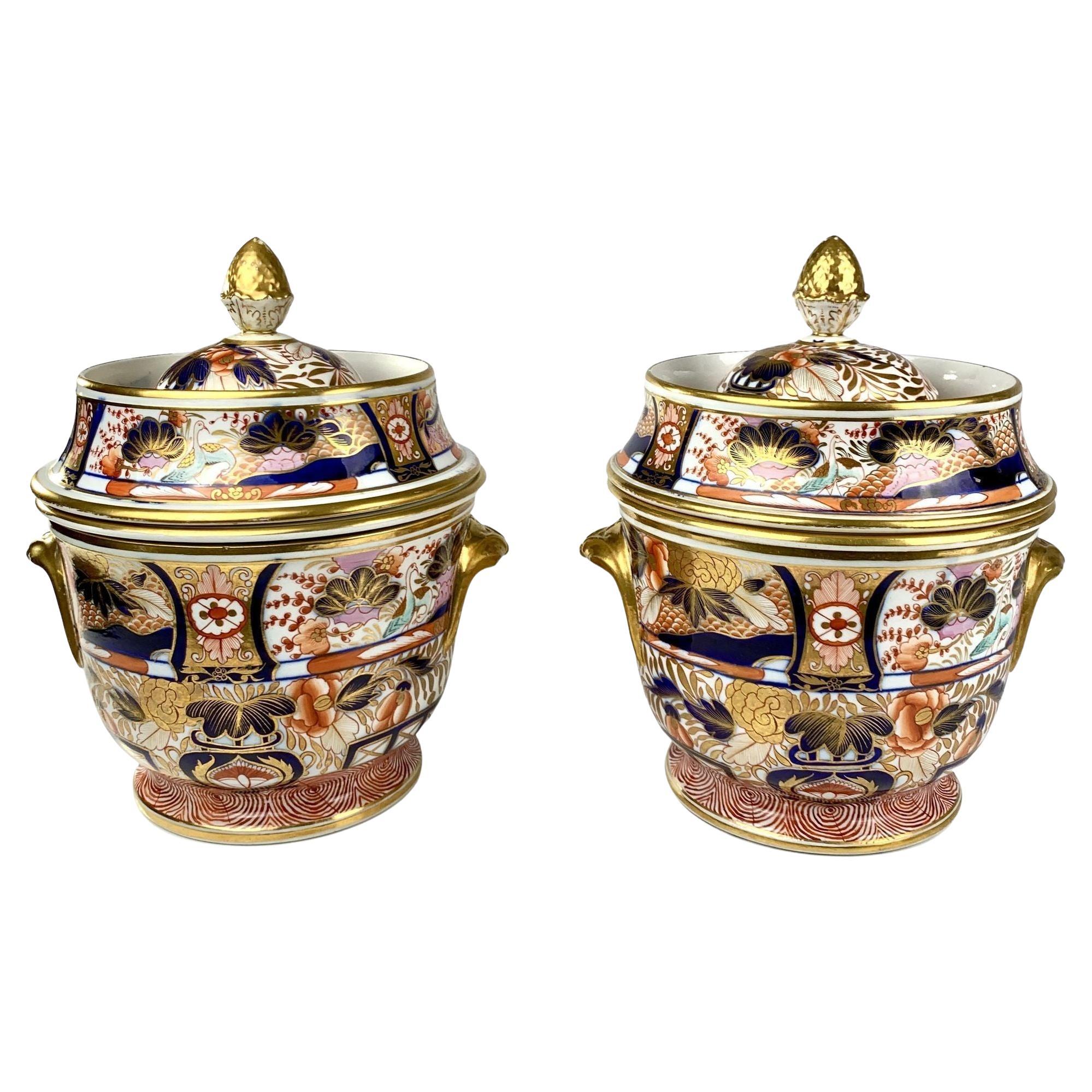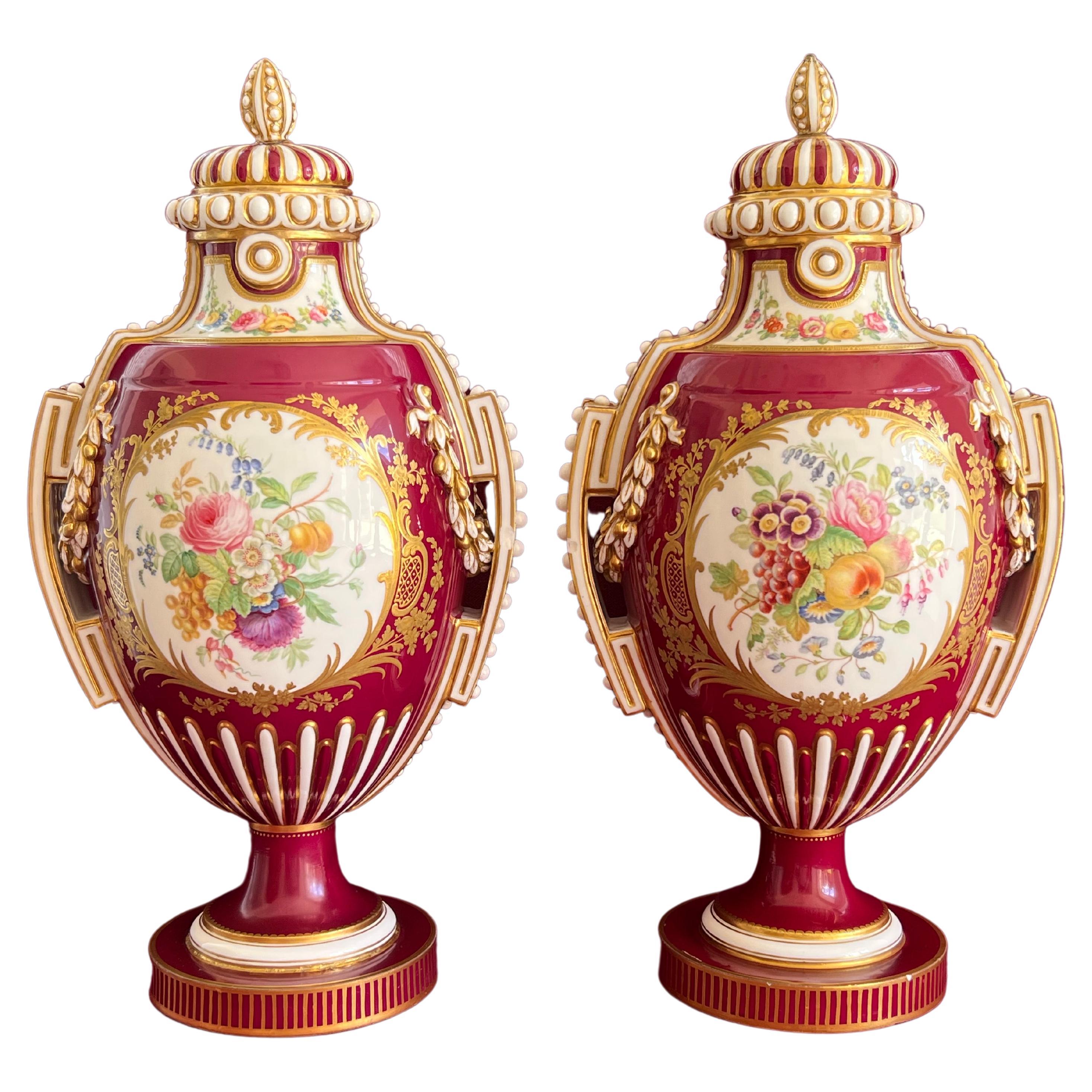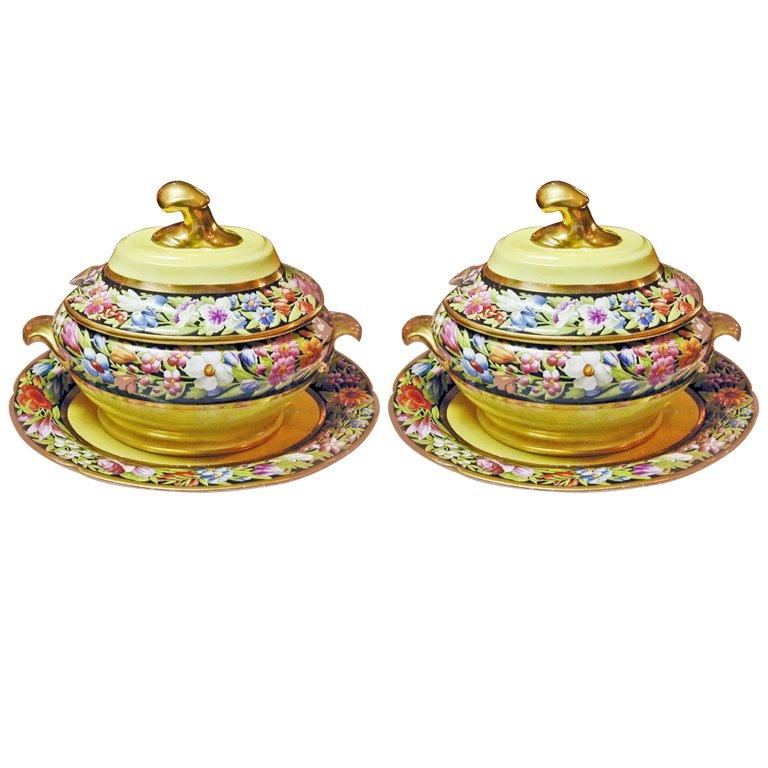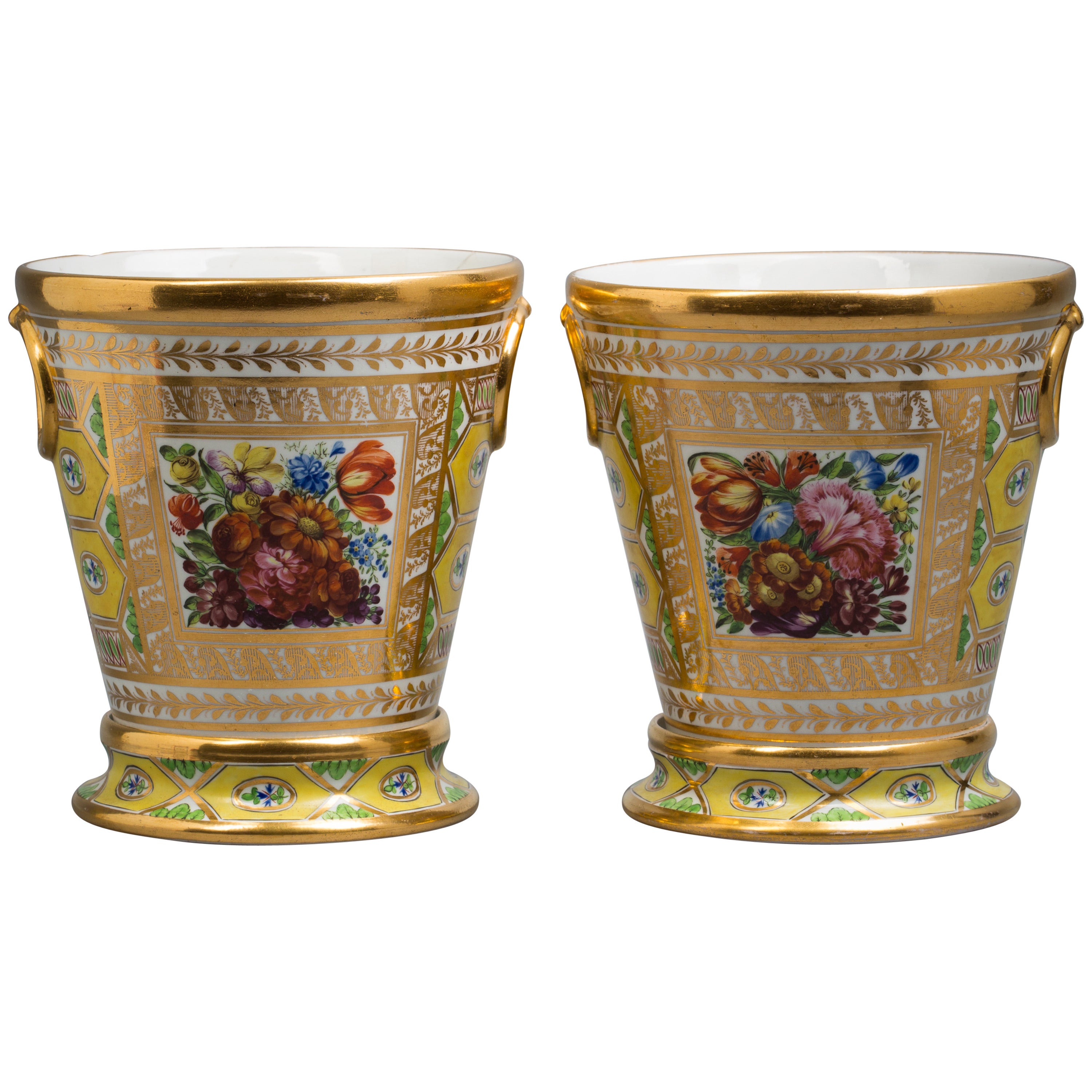Items Similar to Coalport Pair of Floral Gilded Sauce Tureens, Marquess of Anglesey, circa 1820
Want more images or videos?
Request additional images or videos from the seller
1 of 21
Coalport Pair of Floral Gilded Sauce Tureens, Marquess of Anglesey, circa 1820
About the Item
This is an extremely rare set of lidded sauce tureens made by Coalport in circa 1820. The tureens are decorated in the "Marquess of Anglesey" pattern. These sauce tureens would have formed part of a large dessert service. They were used for the sauce to be served on ice cream or a cooked sweet dish, and the lids have holes for the sauce ladles.
Coalport was one of the leading potters in 19th and 20th century, coming out with many innovative designs. The pottery emerged around the year 1800 in Shropshire, right on the edge of Staffordshire and near other great makers such as Spode, Minton, Davenport and many others. They went on to become a major potter in the 19th century and brought out many iconic designs.
The Welsh Nantgarw factory first created the heavily gilded service for the Marquess of Anglesey, with beautifully painted flowers. Later the Swansea factory made additions to or copies of this service, and circa 1820 Coalport added more items. We can tell by the porcelain body that these tureens are by Coalport; it has the very white, simple and slightly uneven porcelain and glaze that Coalport used at the time and it does not look or feel like the Welsh porcelain or glaze. The pattern is exactly the same as the Welsh version but the flowers are painted by a different hand, possibly by one of the London studios that Coalport outsourced their decorations to. What is remarkable about these tureens is their shape: they have masks for finials and on the handles. These masks do not form part of a known Coalport shape, so they may have been especially created for this particular service.
The tureens are unmarked.
Condition report: The tureens are in excellent antique condition with no damage, crazing or repairs. They have some light rubbing, particularly on the masks and along the rims, which can be seen in the pictures.
Antique British porcelain is never perfect. Kilns were fired on coal in the 1800s, and this meant that china from that period can have some firing specks from flying particles. British makers were also known for their experimentation, and sometimes this resulted in technically imperfect results. Due to the shrinkage in the kiln, items can have small firing lines or develop crazing over time, which should not be seen as damage but as an imperfection of the maker's recipes, probably unknown at the time of making. Items have often been used for many years and can have normal signs of wear, and gilt can have signs of slight disintegration even if never handled. I will reflect any damage, repairs, obvious stress marks, crazing or heavy wear in the item description but some minor scratches, nicks, stains and gilt disintegration can be normal for vintage items and need to be taken into account.
There is widespread confusion on the internet about the difference between chips and nicks, or hairlines and cracks. I will reflect any damage as truthfully as I can, i.e. a nick is a tiny bit of damage smaller than 1mm and a chip is something you can easily see with the eye; a glazing line is a break in the glazing only; hairline is extremely tight and/or superficial and not picked up by the finger; and a crack is obvious both to the eye and the finger.
Dimensions: height (incl. finial) 19cm (7.5"), width (incl. handles) 19cm (7.5"), depth 18cm (6").
- Creator:Coalport Porcelain (Maker)
- Dimensions:Height: 7.6 in (19.31 cm)Diameter: 7.6 in (19.31 cm)
- Sold As:Set of 4
- Style:Regency (Of the Period)
- Materials and Techniques:
- Place of Origin:
- Period:
- Date of Manufacture:circa 1820
- Condition:Wear consistent with age and use. In fabulous condition without damage, repairs or crazing and only light rubbing as visible in the pictures.
- Seller Location:London, GB
- Reference Number:
About the Seller
5.0
Platinum Seller
These expertly vetted sellers are 1stDibs' most experienced sellers and are rated highest by our customers.
Established in 2016
1stDibs seller since 2019
208 sales on 1stDibs
Typical response time: <1 hour
- ShippingRetrieving quote...Ships From: London, United Kingdom
- Return PolicyA return for this item may be initiated within 14 days of delivery.
More From This SellerView All
- Coalport Pair of Vases, Persian Revival Gilt with Puce Floral Reserves, ca 1845By Coalport PorcelainLocated in London, GBThis is a stunning and very rare pair of vases made by Coalport in around 1845. The vases have rich gilding in the Persian Revival style, combined with very English floral reserves o...Category
Antique 1840s English Rococo Revival Vases
MaterialsPorcelain
- Three Staffordshire Porcelain Spill Vases Floral Cobalt Blue, Regency circa 1820By StaffordshireLocated in London, GBThis is a set of three little spill vases made by an unknown Staffordshire maker in circa 1820, which was the Regency era. Two of the vases are cobalt blue, one is salmon, and all three have beautiful gilding and hand painted flowers. Spill vases were used for match sticks to kindle the fire. Match sticks in 1820 weren't what they are today: they were short hand-cut sticks of wood and came in bundles. Everyone had a "spill vase" on the mantle piece or on a little side table next to the fire, so that the fire could be kindled at any moment. In the early 19th century there were at some point 300 potteries in Staffordshire, and artists would move from pottery to pottery, attracted by competitive wages. Unless items are clearly marked, it is often difficult to identify them and I have not been able to clearly identify these three spill vases as everyone made them. The two cobalt blue vases are clearly from the same maker; the salmon colored one is slightly shorter and different in shape, but basically the same. All have nicely shaped rims and three charming lion's claws as feet. There is beautiful gilding and stunning hand painted flowers in the reserves. Condition report: All vases have some wear; one of the cobalt blue vases had a foot broken and restuck (this is stable and not very visible when in position) and the salmon vase...Category
Antique 1820s English Regency Vases
MaterialsPorcelain
- Coalport Porcelain Plate, White with Handpainted Flowers, Regency ca 1820By Coalport PorcelainLocated in London, GBThis is a beautiful plate made by Coalport around the year 1820. The plate is decorated in white with a simple gilt rim, darting puce and gilt vines, and a wonderful hand painted bou...Category
Antique 1820s English Regency Dinner Plates
MaterialsPorcelain
- Coalport John Rose Porcelain Plate, White Floral Dulong Blind-Moulded circa 1815By Coalport Porcelain, John RoseLocated in London, GBThis is a beautiful dessert plate made by Coalport in circa 1815. Coalport was one of the leading potters in 19th and 20th century Staffordshire. They worked alongside other great...Category
Antique 1810s English Regency Dinner Plates
MaterialsPorcelain
- Coalport Slop Bowl, Moss Green, Gilt and Flowers, patt. 967, Regency ca 1820By Coalport PorcelainLocated in London, GBThis is a beautiful slop bowl made by Coalport around the year 1820. The bowl has a gadrooned rim, a deep moss green ground with a gilt trellis pattern, and beautiful hand painted fl...Category
Antique 1820s English Regency Serving Bowls
MaterialsPorcelain
- H & R Daniel Pair of Sauce Tureens, Shrewsbury Shape, Flowers, Regency ca 1827By H&R DanielLocated in London, GBThis is a stunning pair of sauce tureens made by H&R Daniel in aboutn 1827. The tureens are made in the popular Shrewsbury shape and have beautiful flower paintings inside the bowls. The tureens are missing their covers and stands, but we have several items of this dessert service available, please see second image and separate listings. Please note that the listing summary erroneously mentions that this is a set of 8 - it is not! It's just 2 pieces. The H & R Daniel porcelain factory was founded by Henry Daniel, son of a family of master colour makers. He headed up the decoration department in the famous Spode factory where he oversaw all the beautiful early Spode decorations. In 1822 he opened his own factory with his son Richard, creating a truly iconic body of work with the most subtle colours and beautifully painted flowers and landscapes. The Daniel factory was the last true cottage industry among the English potteries, resisting the increase of industrialisation and mass production. This resulted in extraordinary and unrivalled quality, but it probably also led to the factory having to close its doors in 1846 because it could no longer compete with others who did modernise. Daniel porcelain can be hard to identify as the factory was only around for about two decades, and Daniel items have therefore become true collectors' items. This set is potted in the Shrewsbury Shape, which was first designed in 1826 for the Earl of Shrewsbury...Category
Antique 1820s English Regency Serving Bowls
MaterialsPorcelain
You May Also Like
- Pair Admiral Nelson Pattern Porcelain Ice Pails England Circa 1810 by CoalportBy Coalport PorcelainLocated in Katonah, NYCoalport Porcelain made this fabulous pair of Admiral Nelson pattern ice pails circa 1810. The intensity of the Imari colors on the Admiral Nelson pattern is quite remarkable. It...Category
Antique Early 19th Century English Jars
MaterialsPorcelain
- Pair of English Porcelain Vases, Coalport, circa 1820By Coalport PorcelainLocated in New York, NYPair of English porcelain vases, Coalport, circa 1820.Category
Antique Early 19th Century English Vases
MaterialsPorcelain
- Superb Pair of Coalport Porcelain Vases Decorated by William CookBy Coalport PorcelainLocated in Exeter, GBA superb pair of Coalport porcelain vases c.1850. Of urn shape with beaded handles, rims and covers picked out in gold, verily finely decorated to both sides with scrollwork panels containing fruit and flowers by William Cook...Category
Antique 19th Century British Rococo Revival Porcelain
MaterialsPorcelain
- Antique Pair of Coalport Porcelain Sauce TureensBy Coalport PorcelainLocated in Baltimore, MDPair of yellow ground Coalport porcelain sauce tureens with bands of beautifully painted flowers will brighten any dining room.Category
Antique 19th Century English Serving Pieces
MaterialsPorcelain
- Pair of English Porcelain Cachepots on Stands, Coalport, circa 1820By Coalport PorcelainLocated in New York, NYPair of English porcelain yellow-ground cachepots on stands, Coalport, "Church Gresley" Pattern, circa 1820.Category
Antique Early 19th Century English Planters, Cachepots and Jardinières
MaterialsPorcelain
- Pair of English Porcelain Demilune Boughpots and Covers, Coalport, circa 1820By Coalport PorcelainLocated in New York, NYPair of yellow ground English porcelain demilune boughpots and covers, Coalport, circa 1820.Category
Antique Early 19th Century English Planters, Cachepots and Jardinières
MaterialsPorcelain
Recently Viewed
View AllMore Ways To Browse
White Porcelain China
Chinese White Porcelain
Large Porcelain Sign
Brown And White Porcelain
British Regency
Antique British Porcelain
Heavy Gilt Porcelain
Antique Stained Glass Designs
Regency Glass Flower
Porcelain Flower Light
Hand Painted Stained Glass
Porcelain Dessert Set
Stained Glass Flowers
Antique Silver Bit
Unmarked Porcelain
Rare Antique Chinese Porcelain
Large Antique Porcelain Signs
Antique Porcelain Chinese Signs





